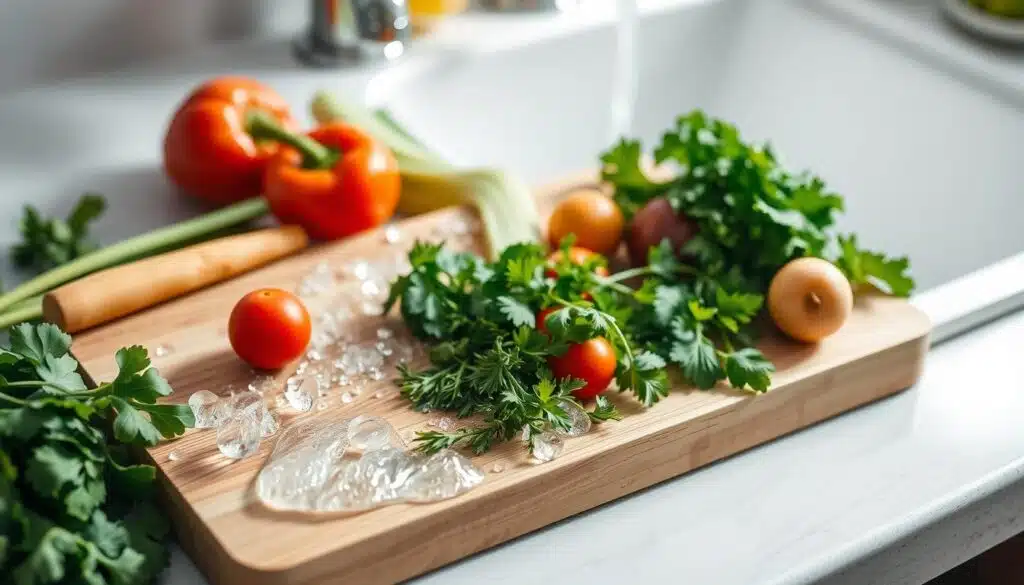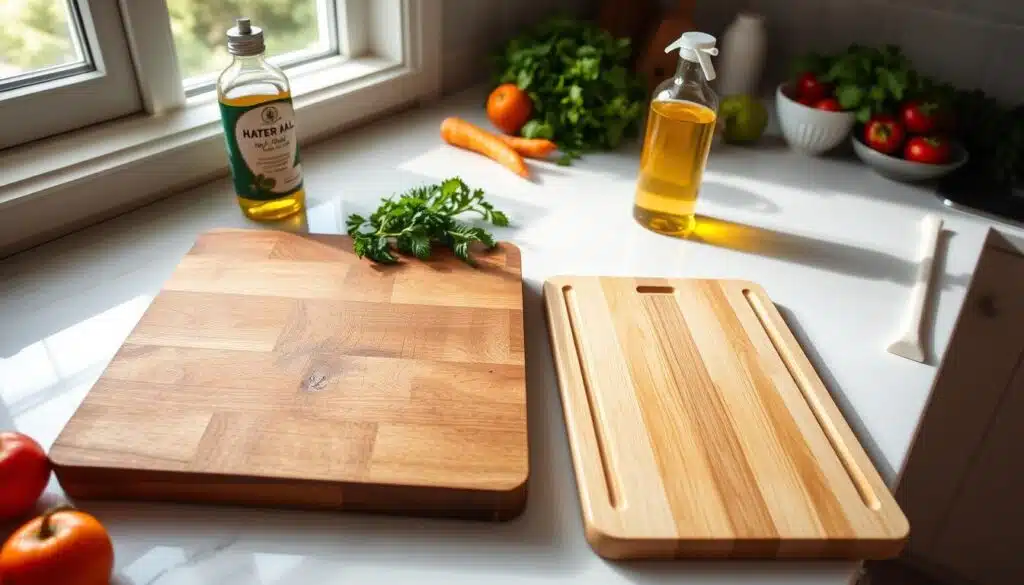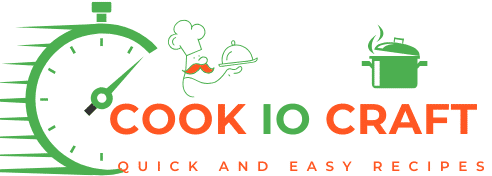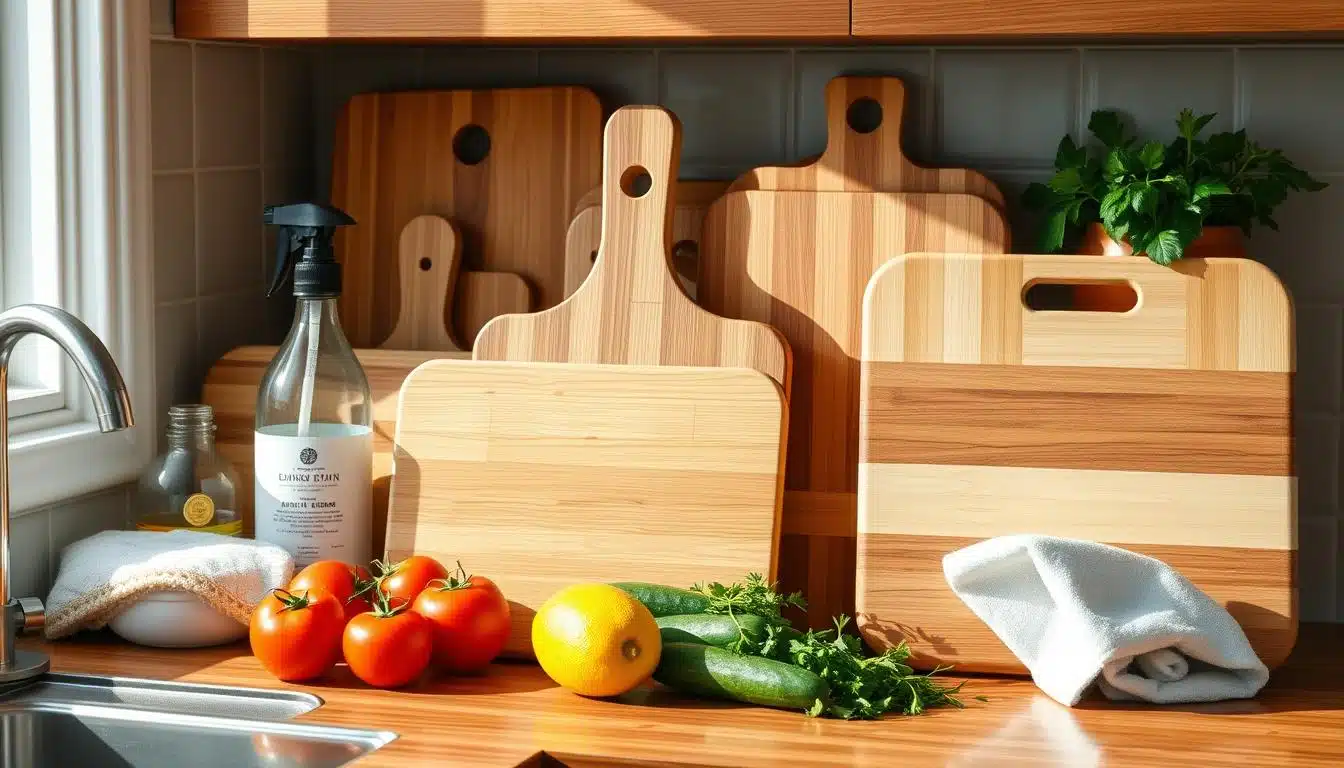We know you’re busy with work, family, and more. You’re looking for quick, tasty recipes online. At our kitchen, we think keeping cutting boards clean is key. Washing them after each use is vital for safety and hygiene.
By following our tips, your cutting boards will always be clean. This lets you cook with confidence. We’ll show you how to clean them regularly, deep clean monthly, and store them right.
Key Takeaways
- Wash your cutting boards after every use to prevent bacterial contamination
- Designate different cutting boards for various food categories to prevent cross-contamination
- Use natural ingredients like lemon juice and salt for monthly cleaning
- Regularly oil your wooden cutting boards to maintain their quality
- Replace your cutting boards if they show signs of deep grooves, cracks, or excessive wear
- Proper drying and storage are essential to prevent cracks and warping in wooden cutting boards
- Cutting board care is an important part of kitchen hygiene and food safety
Importance of Clean Cutting Boards
Keeping our kitchens clean is key to staying healthy, and Cutting Boards Clean practices are a crucial part of this. Regular cleaning of your cutting boards helps prevent the spread of harmful bacteria and keeps your kitchen spotless.
Cutting boards are a big deal in the kitchen. They can hold onto bacteria and germs if not cleaned right. By focusing on cutting board care, we can lower the chance of getting sick and keep our kitchen safe.
Why Germ-Free Cutting Boards Matter
Clean cutting boards are vital for a healthy kitchen. They help stop bacteria and germs from spreading. This is crucial when we handle raw meat, poultry, and seafood, as they can carry harmful bacteria like Salmonella and E. coli.
Health Risks of Dirty Cutting Boards
Dirty cutting boards can be very dangerous. Bacteria like Salmonella and E. coli can grow rapidly on them, leading to food poisoning. Proper Cutting Boards Clean practices are essential to avoid these risks.
To keep cutting boards clean, wash them with soap and water after each use. Sanitize them often and dry them well to avoid moisture. These simple steps help keep our cutting boards germ-free, reducing the chance of getting sick and keeping our kitchen clean.
- Reduced risk of foodborne illnesses
- Improved kitchen hygiene
- Extended lifespan of cutting boards
- Prevention of bacterial growth
By focusing on cutting board care and keeping our kitchen clean, we make a safe space for cooking and eating. This promotes healthy habits in the kitchen.
Types of Cutting Boards and Their Care
Choosing the right cutting board is key for kitchen hygiene. There are many types, each with its own care needs. Proper cutting board care stops cross-contamination and keeps food safe.
Popular cutting boards include wood, plastic, and bamboo. While all require attention to Cutting Boards Clean practices, wooden boards offer a natural advantage as they possess inherent antibacterial properties. Bamboo boards, made from fast-growing bamboo, are also a popular choice due to their eco-friendly nature.
Here are some key characteristics of different types of cutting boards:
- Wooden cutting boards: durable, natural antiseptic properties, and easy to clean
- Plastic cutting boards: durable, easy to clean, but may harbor bacteria
- Bamboo cutting boards: sustainable, natural antimicrobial properties, and soft on knives
Proper cutting board care is vital for kitchen hygiene. This means regular cleaning, sanitizing, and upkeep. By following these tips and picking the right board, you’ll keep your kitchen clean and safe.
Daily Cleaning Tips for Cutting Boards
Keeping your cutting boards clean is key to stop bacteria and germs from growing. Always wash your cutting boards after each use, especially when cutting raw meat, poultry, or fish. A clean cutting board is vital for food safety and quality, especially for Quick and Easy Recipes.
Just a quick rinse and wipe can help a lot. Rinse the board with warm water and dry it with a clean towel. For a deeper clean, use soap and water to scrub it, focusing on any stains or residue.

- Use a gentle dish soap and avoid abrasive cleaners that can damage the board’s surface.
- Avoid using bleach or other harsh chemicals, as they can dry out or discolor the board.
- For wooden cutting boards, apply a small amount of oil after cleaning to keep the wood moisturized and protected.
By following these daily cleaning tips, you can keep your cutting boards clean, germ-free, and in good condition. This makes it easier to prepare Quick and Easy Recipes with confidence.
| Cutting Board Type | Cleaning Method |
|---|---|
| Wooden | Soap and water, followed by oiling |
| Plastic | Soap and water, or dishwasher safe |
Deep Cleaning Your Cutting Boards
Deep cleaning your cutting boards is key to kitchen hygiene and cutting board care. It gets rid of tough stains, bacteria, and smells. These can harm your food and family health.
To deep clean, mix baking soda and water into a paste. Spread it on the board and wait 30 minutes. Then, rinse with warm water.
When to Deep Clean
Deep clean your cutting boards every 1-3 months. This depends on how much you use them. If you see tough stains or smells, clean them more often.
Recommended Deep Cleaning Solutions
There are many ways to deep clean your cutting boards. Here are a few:
- Baking soda and water
- White vinegar and water
- Lemon juice and salt
How to Deep Clean Wood Boards
For wood cutting boards, mix oil and lemon juice. Apply it and wait 30 minutes. Then, wipe it clean with a dry cloth.
By following these tips, you can keep your cutting boards clean. This ensures your food is prepared safely and healthily.
| Cutting Board Type | Cleaning Method |
|---|---|
| Wood | Oil and lemon juice |
| Plastic | Bleach solution |
| Bamboo | Vinegar and water |
Cutting Board Maintenance and Longevity
To keep your cutting boards in great shape, follow good kitchen hygiene and use the right cutting board care methods. Clean them often, oil them sometimes, and store them properly.
Wooden cutting boards need special care to stay clean and last long. Regular oiling, a key part of proper Cutting Board Care, boosts the wood’s natural antibacterial properties. This stops bacteria from getting into the wood. Using the right oils for seasoning helps fix small damages and prevents bigger problems, making the board last longer.
Here are some tips for keeping your cutting boards in top condition:
- Clean the cutting board after each use
- Apply mineral oil regularly to remove stains, odors, and make it more water-resistant
- Season the cutting board with food-grade oil to add years of life to the board and protect it from harmful bacteria
By following these tips, and prioritizing Cutting Boards Clean, your cutting boards will stay in great shape for a long time. Always remember to keep your kitchen clean and your cutting boards well cared for. This keeps your cooking area healthy and safe.
| Cutting Board Type | Maintenance Requirements |
|---|---|
| Wooden | Regular oiling, proper storage |
| Plastic | Regular cleaning, replacement when damaged |
How to Remove Stains and Odors
Keeping your kitchen clean is key, especially when it comes to cutting board care. We know you’re always on the go, looking for Quick and Easy Recipes. You also want to keep your cutting boards in top shape.
To tackle stains, baking soda is your go-to. Just apply it to the stain, mix with water to form a paste, and let it sit for 30 minutes. Then, rinse with warm water and dry it well.
For odors, vinegar is your best friend. Mix equal parts water and white vinegar in a spray bottle. Spray the board and let it air-dry before storing. This method is simple and keeps your cutting boards in great condition.
Here are some extra tips for stain and odor removal:
- Use a gentle scrubber to avoid damaging the board
- Avoid using harsh chemicals that can damage the board or harm your health
- Regularly oiling your cutting board can help prevent stains and odors
By following these easy tips, you can keep your cutting boards clean and free of stains and odors. This makes it easier to cook Quick and Easy Recipes for your family.
| Method | Effectiveness | Ease of Use |
|---|---|---|
| Baking Soda | High | Easy |
| Vinegar Solution | High | Easy |
Disinfecting Your Cutting Boards
Keeping your kitchen clean is key, and Cutting Board Care, including Cutting Boards Clean practices, is a big part of it. It’s important to disinfect your cutting boards regularly to stop bacteria from spreading. Since we use them so frequently, they can easily become contaminated with harmful germs.
To keep your cutting boards clean, you have a few options. Using lemon juice is a good choice. Just cut a lemon, sprinkle sea salt on it, and rub it on the board. It’s a natural way to clean without harsh chemicals.
Here are some more tips for keeping your cutting boards clean:
- Use a mix of chlorine bleach or vinegar to sanitize your cutting boards.
- Scrape your wooden cutting board with a steel scraper or spatula to remove moisture.
- Oil or reseason your wooden cutting board often to prevent damage.
By following these tips, you can make sure your cutting boards are always clean. This way, you can cook with confidence, knowing your kitchen is safe and healthy. Remember, good kitchen hygiene and cutting board care are crucial for a clean cooking space.
| Cutting Board Type | Disinfecting Method |
|---|---|
| Wooden | Vinegar solution or lemon juice |
| Plastic | Bleach solution or dishwasher |
| Bamboo | Vinegar solution or natural oils |
Avoiding Cross-Contamination
To keep your kitchen clean, it’s important to avoid cross-contamination. Use separate cutting boards for raw meat and other foods. This stops harmful bacteria from spreading.
Using a color-coded system makes Cutting Boards Clean easier. For example, use a red board for raw meat and a green one for veggies. This simple strategy keeps your kitchen clean and safe.
Cleaning your cutting boards often is also key. Use a sanitizing solution like one tablespoon of unscented bleach per gallon of water. Make sure they dry completely to stop bacteria growth.
By following these tips, you can keep your kitchen clean and safe. Remember, stopping cross-contamination is crucial to prevent bacteria spread.
Signs It’s Time to Replace Your Cutting Board
Keeping your kitchen clean is key, and that includes your cutting board. It’s important to know when it’s time for a new one. This helps stop bacteria and germs from getting into your food.
Here are some signs your cutting board needs to be replaced:
- Cracks and gouges: If your cutting board has deep cracks or gouges, it can hold onto bacteria. This makes it hard to clean and sanitize.
- Persistent odors: If your cutting board smells bad even after cleaning, it might be full of bacteria.
Even with good care, like sanitizing and drying, cutting boards need to be replaced. This is every one to five years, depending on how often you use it and what it’s made of.

Knowing when to replace your cutting board is important. By taking care of it and following good kitchen hygiene, you can keep your cooking area safe and healthy.
| Material | Lifespan | Maintenance |
|---|---|---|
| Plastic | 1-5 years | Easy to clean and sanitize |
| Wood | 5-10 years | Requires regular oiling and waxing |
| Bamboo | 5-10 years | Requires regular oiling and waxing |
Eco-Friendly Cleaning Solutions
When it comes to cutting board care, we want to keep our boards clean and germ-free. Cutting Boards Clean practices are essential, and eco-friendly cleaning solutions are perfect for this. They’re good for the environment and gentle on our boards. Plus, they help keep our boards in top shape. For those looking for quick and easy recipes for Cutting Boards Clean, we have some great options.
Natural Ingredients for Safe Cleaning
Natural ingredients like vinegar and hydrogen peroxide are great for cleaning cutting boards. They kill bacteria and germs without harming us or the environment. Vinegar is especially good because it’s cheap and works on many surfaces.
DIY Cutting Board Cleaner Recipes
Here are a few DIY cutting board cleaner recipes you can try at home:
- Recipe 1: Mix 1 cup of water with 1/2 cup of white vinegar for a natural disinfectant.
- Recipe 2: Mix 1 tablespoon of hydrogen peroxide with 2 cups of warm water to kill bacteria and germs.
Using these eco-friendly cleaning solutions helps keep your cutting boards clean and safe. It also helps the environment. Always clean your cutting boards after cutting raw meat or poultry to stop bacteria and germs from spreading.
Tips for Educating Your Family
Keeping your cutting boards clean is key to kitchen hygiene. It’s also about teaching your family safe food prep. By getting your kids involved, you can teach them habits that last a lifetime.
Teaching Safe Food Prep Practices
Begin by talking about cross-contamination and health risks from dirty cutting boards. Show them how to clean with hot, soapy water or lemon juice. Teach them to use different boards for raw meat and veggies to stop bacteria spread.
Involving Kids in Kitchen Cleanliness
Make cleaning cutting boards a family affair. Have your kids help scrub and dry them. Explain why cleaning is important and let them help keep the kitchen germ-free. This teaches them important skills and makes them feel responsible.
Teaching your family about cutting board care makes your kitchen safer and healthier. Good hygiene starts at home, and your family can help keep it that way.
FAQ
What is the best thing to clean a cutting board with?
The best way to keep your cutting boards clean depends on the material. For most cutting boards (wood, plastic, bamboo), warm soapy water is a great starting point. For extra cleaning power, you can use a solution of white vinegar and water. Remember that proper Cutting Boards Clean methods are essential for food safety.
Does vinegar disinfect a wood cutting board?
Vinegar has some antimicrobial properties, but it’s not considered a registered disinfectant by the EPA. While it can help reduce bacteria on a wood cutting board, it might not eliminate all of them. Therefore, while vinegar can be part of your Cutting Boards Clean routine, it shouldn’t be relied upon as the sole sanitizing agent.
What do chefs use to sanitize cutting boards?
Chefs often use a combination of methods for Cutting Boards Clean and sanitizing, including:
- Hot, soapy water: A fundamental first step.
- Sanitizing solutions: Food-safe sanitizers like diluted bleach solutions or quaternary ammonium compounds are commonly used. It’s crucial to follow the manufacturer’s instructions for dilution and contact time.
- Regular replacement: Over time, cutting boards can develop deep grooves that harbor bacteria, so replacement is necessary.
How do you get bacteria out of a wooden cutting board?
Getting bacteria out of a wooden cutting board requires a multi-pronged approach to Cutting Boards Clean:
- Scrub with hot, soapy water: Use a dedicated cutting board brush.
- Rinse thoroughly: Make sure to remove all soap residue.
- Sanitize: Use a diluted bleach solution (follow guidelines carefully) or a food-safe sanitizer.
- Allow to air dry completely: Moisture breeds bacteria.
- Regularly oil: This helps prevent cracking and makes the board less hospitable to bacteria.
Can I use Dawn on a wood cutting board?
Yes, you can use Dawn dish soap on a wood cutting board. It’s effective at cutting grease and removing food particles. However, make sure to rinse the board thoroughly to remove all soap residue, as this can affect the flavor of food and potentially cause digestive upset. Dawn is a good option for the initial cleaning stage of Cutting Boards Clean.
Does hydrogen peroxide clean cutting boards?
Hydrogen peroxide can be used to clean cutting boards. It has some antibacterial properties and can help remove stains. However, like vinegar, it’s not a registered disinfectant. It can be a helpful addition to your Cutting Boards Clean routine, but shouldn’t be the only method used for sanitizing. Always use food-grade hydrogen peroxide and rinse the board thoroughly after use.

